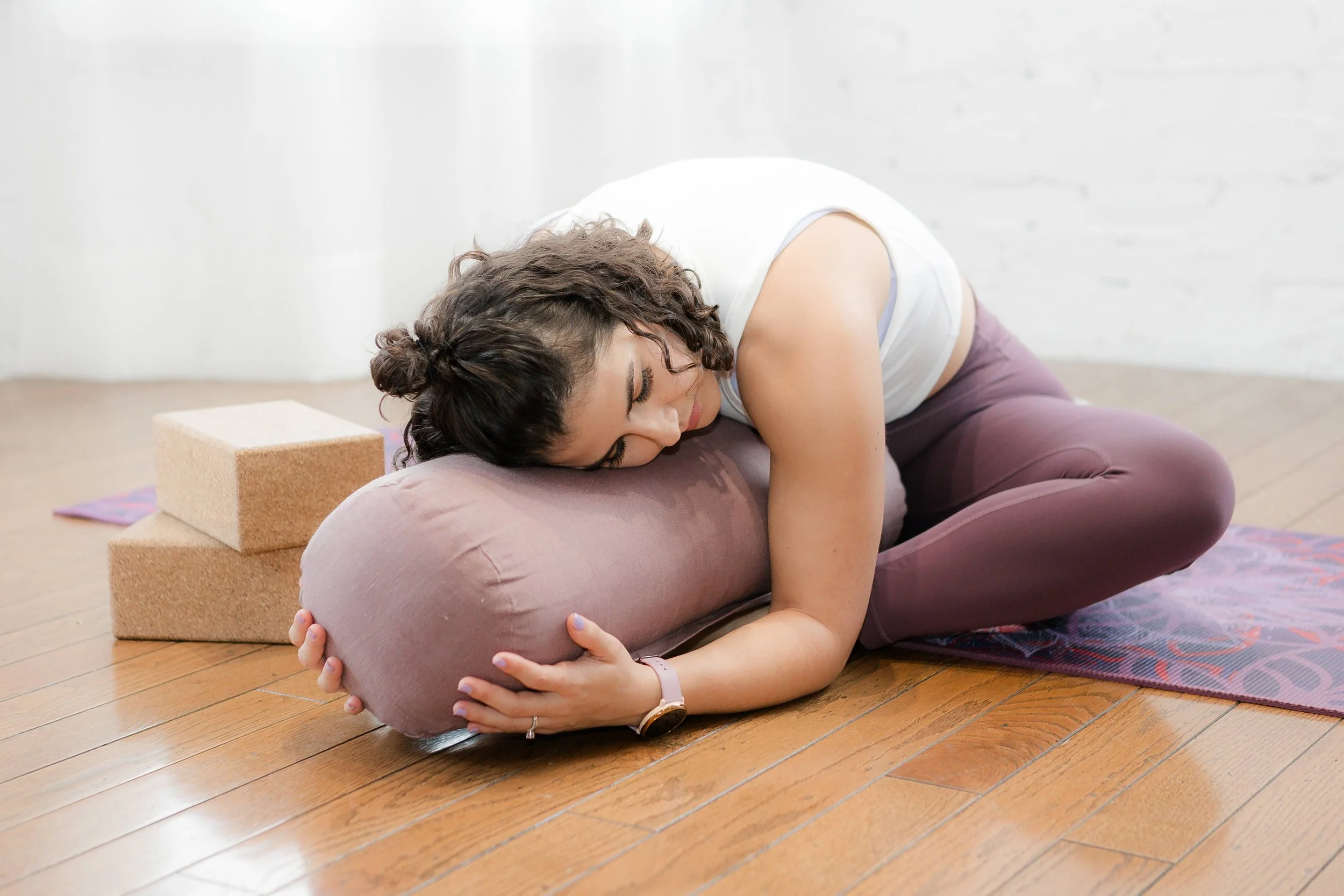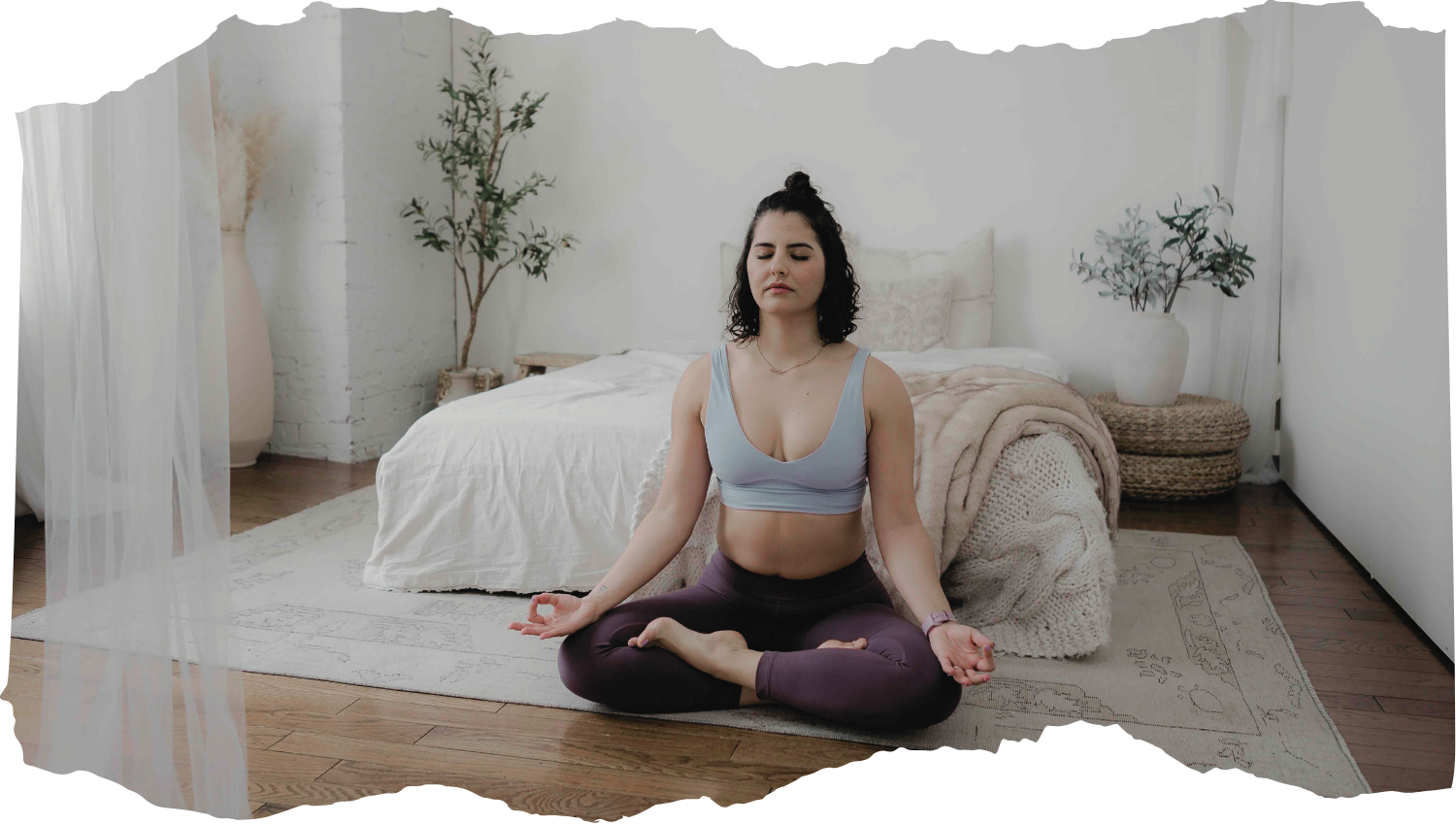The stillness we resist is the medicine we need (and how yin yoga can bridge the gap)
Shhh.
Listen closely.
They’re quiet and subtle, longing to be heard.
Until they have no choice but to get so loud they become impossible to ignore.
I’m not speaking about critters or unsung heroes, but about our body’s whispers—the ones we sometimes dismiss or fail to listen to.
We live in a fast-paced, overproductive, and almost-always-on-fire world—a world shaped by oppressive systems, burnout, and a hyperfocus on doing. We move through our days on autopilot, pushing through despite what our bodies might be feeling or trying to say.
We feel guilty if we slow down, yet pressured to keep showing up.
And while life won’t pause for us to hop off this ride, what if we find serenity within?
What if the stillness we resist is the medicine we need?
What if the way “out” is actually the way “in?”
Stillness is… hard.
Wake up, shower, commute, work, do, do, do, work out, eat, maybe get a few hours of sleep. Repeat.
That’s the routine that led me to burnout and ER visits in 2018.
I didn’t know what being still was. I had normalized doing more than being, praising, and equating success with staying busy and striving for more.
With technology, capitalism, and hustle culture, many of us associate rest with laziness or lack of productivity. No wonder being still is difficult, especially when navigating mental, emotional, or physical pain, overstimulation, or neurodiversity.
But in truth, our nervous systems crave rest.
And stillness might be the radical practice we need to drop into the present moment, listen to what the body is saying, and then tend to it accordingly—so we can continue to show up for ourselves, others, and the world.
That’s where yin yoga comes in: it offers an opportunity to practice stillness, providing a space to land, soften, and yield to the subtle whispers (and sometimes screams) within.
What exactly is yin yoga?
Yoga is typically known in the West as a style of exercise to stretch and get flexible. However, it’s much more than a workout—it’s an Indian philosophy that shows us the path to self-realization.
The movement side of yoga (or Asana) means “seat” and is only one of the 8 limb path according to the Yoga Sutras of Patanjali. The purpose of Asana is to cultivate the ability to sit in meditation for extended periods of time.
Yin yoga is a practice that specifically focuses on finding stillness and sitting with what is. Unlike dynamic (yang) Hatha yoga, which focuses on muscle engagement, yin targets deep connective tissues (bones, ligaments, tendons, joints, fascia) with passive, long-held, floor postures. It’s an invitation to surrender to the present moment, slow down, and feel into your body, releasing the need to force, push, or perform.
The three Tattvas or principles of yin yoga are:
Coming into your appropriate edge of sensation in a posture
Finding stillness of the mind, body, and breath
Holding the poses for time (2-5+ minutes)
Explore this practice (and the whispers it uncovers) in our online workshop: Whispers from Within
Where does yin yoga come from?
In the 1970s, Paulie Zink introduced yin yoga as “Taoist Yoga”—a combination of martial arts, Taoism, and Hatha Yoga. The goal was to tap into the body’s wisdom by connecting with animals, the elements, and nature, and moving in harmony with this energy.
Then, Paul Grilley, one of Paulie’s students, took it a step further—combining Taoist Yoga with his anatomy knowledge and the Chinese meridian theory he learned from Dr. Hiroshi Motoyama.
Sarah Powers attended Paul’s classes and fell in love with the long-held floor postures and how valuable they were for her meditation practice. She started sharing them with her students and suggested the name “Yin Yoga” as they reflected the more passive side of Paulie’s Taoist Yoga.
Lastly, Bernie Clark, who studied with both Sarah and Paul, popularized yin yoga throughout the world. He draws from Taoism, science, mythology, psychology, and Zen meditation, and has written The Complete Guide to Yin Yoga, while also running www.yinyoga.com, both essential resources to learn more about this practice.
How I “yanged” my way through yin—and what changed.
When I started practicing yin yoga, I thought the whole point was to stretch as far as I could and hold on to dear life.
With time, and thanks to my teachers, training, and lots of studying, I realized I was letting ego and perfectionism lead me into places I couldn’t really stay in, potentially hurting myself, and missing the whole point of the practice.
I was “yanging” my way through it.
It wasn’t until I started to soften instead of gripping and yielding instead of pushing, that the magic of stillness started to unfold.
I learned it wasn’t about reaching the maximum edge, but exploring the Goldilocks point—not too much, not too little, just right. Or like Bernie says: “not too deep, which creates degeneration, and not too little, which creates atrophy.”
“We do not use the body to get into a pose; we use the pose to get into the body.”
Bernie Clark
I began to tune in and listen to what stillness was unveiling: physical sensations, stuck energy, thought patterns, emotions, and even deep spiritual longings. I sat with them, noticing them with compassion, and then taking informed action.
That’s when yin yoga became a sacred practice of returning, of coming home to myself.
And now I’m honored to share it with you.
Whispers from Within
This 2-hour online workshop combines yin yoga and journaling to help you let your foot off the pedal and reconnect with your inner knowing.
Why do we need yin yoga (especially right now)?
According to Taoism, having a balanced and whole life requires honoring both the yin (feminine, passive, still, and cooler side) and the yang (masculine, active, dynamic, and fiery side).
Nurturing yin in a yang world (and especially during yang seasons) through yin yoga allows us to balance our energy and reap the numerous physical, mental, and emotional benefits of this practice.
Physical benefits of yin yoga
Improves mobility and flexibility. Enhances flexibility by stretching and lengthening deep connective tissues, which then supports the ability to move with strength and control.
Stimulates cell lubrication. Encourages tissue hydration and circulation through the fascia, allowing joints to move and fascia to slide more easily.
Supports cellular flow. Liquifies the fluids in the cellular matrix (ground substance), facilitating the cells’ natural exchange and flow through the tissues.
Promotes bone health. Reduces degeneration of bone and the risk of osteopenia (low bone density) and osteoporosis (advanced bone weakening disease).
Reduces stress levels. Which can lower blood pressure, slow down your heart rate, improve digestion, and decrease inflammation.
Mental + emotional + energetic benefits of yin yoga
Regulates your nervous system. Switching from the sympathetic (fight or flight) to the parasympathetic system (rest and digest).
Fosters awareness and mindfulness. Encourages you to slow down, focus on the present moment, and notice what’s coming up with curiosity and without judgment—including any sensations, thoughts, emotions, and beliefs that arise.
Cultivates responses vs. reactions. As you gain clarity of what’s happening here and now, you may practice having a more intentional response and even explore changing patterns or creating new habits.
Enhances energy flow. Awakens, balances, and promotes the flow of prana or life’s force, allowing you to move and release any emotions or stuck energy throughout your body.
Nurtures your vitality by stimulating and balancing your body’s energetic channels (or Traditional Chinese Medicine’s meridians).
5 tips to practice (and enjoy) stillness through yin yoga
1) Search for your picnic spot.
Don’t do what I did at the beginning—going to the max edge of sensation and suffering through it. Begin a pose by breathing into it, scouting the terrain as if you were walking around a park looking for a spot to unfold your picnic blanket.
Once you find your first stopping point, where you can feel it but you are not in pain, stay. Keep breathing. After a few minutes, the body may open up and invite you to your next stopping point. Or perhaps you took it too far and want to dial it back or move your picnic blanket somewhere else. Give yourself permission to explore before lingering in the pose.
2) Props are your allies (not a sign of weakness).
Echoing my dear friend and yoga teacher Bonnie, “props are your friends, not your enemies.”
Blocks, bolsters, pillows, blankets, etc., are all fantastic ways to support your practice and make the poses more accessible. They can bring the earth to you, help you adjust your positioning, and sometimes deepen the stretch (even though deeper is not necessarily better).
No props? Sofa cushions, thick books, and throw blankets can be great options at home. Play with them until you find what works for you.
3) If the mind wanders… Find your anchor.
The mind will roam wild—it’s natural to get distracted, zone out, or let the thoughts take over.
The intention is not to clear the mind, but to observe what’s happening and redirect the focus. Use your breath, a mantra, or sensations as anchors to return to your body and your practice again, and again, and again.
A few helpful mantras can be inhale “I am,” exhale “here,” or inhale “I’m breathing in,” exhale “I’m breathing out.”
4) Prioritize time over intensity (without going overboard).
To go “deeper” in yin means to hold the postures for longer periods of time rather than to go further on your edge of sensation.
As a general recommendation, yin poses are typically held for at least one minute. If you are practicing by yourself, use a timer or keep an eye on your watch to monitor the length of your postures—1-2 minutes if you are a beginner, and then work up to 3-5+ minutes as you get used to the practice.
Listen to your body and feel free to adjust or skip a posture as needed. If anything feels painful, numb, or unsafe, please exit the pose immediately. You are your greatest teacher!
5) Bring a journal along.
Pairing the movement practice with journaling can enrich your experience. The page may become a place to release, put into words, or reflect on what comes alive while in stillness.
Think of it as an avenue to make sense of the whispers within, whether through short or long form writing, drawing, doodling, or any other creative outlet.
An invitation to slow down + listen.
If you’ve been feeling exhausted or disconnected from your body, trapped in a cycle of doing and burning out, or wanting to slow down and listen to your wisdom…
Take the next step: register for Whispers from Within to bring more stillness into your life.
This 2-hour online workshop combines yin yoga and journaling to help you let your foot off the pedal and reconnect with your inner knowing.
You’ll get:
An embodied journey of guided meditation, yin yoga, and journaling, with accessible variations to find what works for you
An opportunity to land, tune in, and soften into your truth, while sharing space in community
Access to the replay, playlist, and journaling prompts to come back to as needed
No yoga experience required.
The whispers are there, waiting to be heard.
What becomes possible when you pause and listen?
*Scholarships are available, you can inquire about one through this form
Hi there, so lovely that you're here! Looking forward to connecting with you. - Nora




